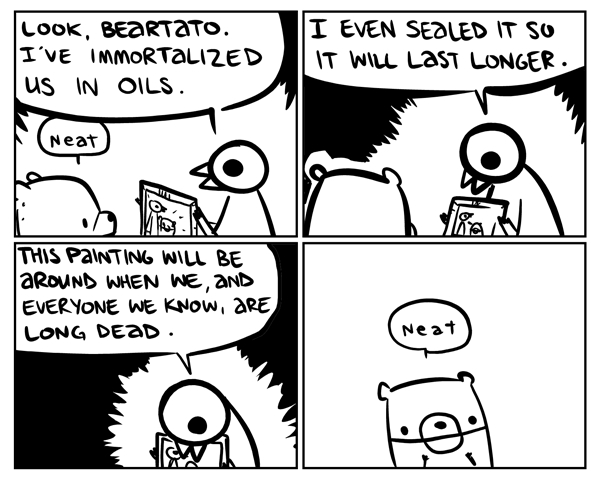From long-running soap operas to comedy-drama slices of life to daily gag strips, the digital comics scene has exploded over the last decade and readers have never had more options. Feeling overwhelmed? Jen Overstreet and Joe Stando are here to take you on an expedition through the webcomics wilderness and show you the best specimens in our monthly Deadshirt Webcomics Field Guide.
Anthony Clark’s Nedroid Picture Diary is one of the most consistently delightful webcomics available today. It follows the adventures of best friends Beartato (half bear, half potato) and Reginald (a bird). These two anthropomorphic protagonists are best friends, in a Saturday-cartoon or Sunday-funnies world where the rules of physics and sense don’t matter. Made up mostly of single-page gags or long stories split into single-page gags, stories in Nedroid Picture Diary range from sitcom-like to otherworldly. Any given set of strips features subjects anywhere from using computers, going to the library, and going on dates, to seeing ghosts, meeting wizards, jumping into space, turning into vampires.
Nedroid Picture Diary’s archives run back to 2005, but suggestions in the author notes (from a more ancient time referred to only as “the old site”) imply that some may actually date back to 2001.
If reading from the beginning, Nedroid Picture Diary’s story doesn’t start so much as trickle in, offering a rather loose-knit set of simple gag strips before any greater narrative or definition of the Nedroid Picture Diary Universe is established. Beartato does not appear until the seventh comic, and Reginald appears with him in the eleventh. From that point on, the story largely follows the pair and their friends & nemeses, but is occasionally punctuated by unrelated gags. Occasional multiple-comic arcs are sprinkled into the comic, but in general continuity is unimportant, or rather, repeatedly rewritten as a gag.
As a scientist of humor, the question remains—what is the source of Nedroid Picture Diary’s consistent success? How has it captivated our hearts and our funnybones for so long? Surely our complex times require more than the childlike delight of the funny bird and bear show to keep coming back week after week.
Let’s explore some of the secret humor recipes that make up this stew:
The Too Literal
Nedroid Picture Diary explores in depth the only form of humor in the pun family I find acceptable: the literal interpretation of colloquialisms and turns of phrase. Perhaps originally perfected by The Muppet Show, Clarke follows and excels in that esteemed tradition.
 Comedic Reaction to Existential Dread
Comedic Reaction to Existential Dread
It’s important to keep things edgy and relevant, because as we become older the humor centers stretch further away from our laugh receptors and become clouded with a substance called ennui. Breaking through this requires topics we immediately recognize, like anxiety and fear of the deep dark unknown. Keep it light, though, there are kids reading. Probably.
 One of These Facts is Real, the Other is Fake!
One of These Facts is Real, the Other is Fake!
It’s important to be educational, because knowledge is power, but not too educational, because a wise man knows himself to be a fool.
Other prevalent gags included in Nedroid Picture Diary, but by no means a complete list, include:
- A Hilarious Misunderstanding
- Fugue State/Variations on a Theme
- Cat Comics
- All of These Facts are Lies, Actually
- Topical Subjects Waylaid by Apathy About Topical Subjects
- Garfield References
Truthfully, however, the real nuclear core of humor comes back to Nedroid Picture Diary’s odd couple protagonists and their differences. Beartato: friendly cool guy, earnest, self-confident, concerned. Reginald: self-serving, mean, arrogant, and deeply anxious and insecure. They are always at odds, but each is always deeply loving and codependent on their best friend. They strike a captivating balance between wacky wholesomeness and wacky irreverence. The simplicity of this dynamic allows them to explore wild and fantastical territory as easily as Beartato’s living room.
Though very simplified in form, Beartato, Reginald and friends are brought to bafflingly expressive life under Clark’s stylus. When an artist can express so much in so few panels, my thoughts begin to wander to the lost grimoires of Watterson and Bushmiller. Back in reality, however, there actual non-magical artistic devices that power Nedroid Picture Diary, in particular Clark’s deep understanding of Less is More. Uncluttered backgrounds and simple gags leave room for adequate pacing and keep focus on the characters and their expressions. Exactly because the figures are so simplified, a juxtaposition of text, a few exclamation lines, and a slight change in the opening of a beak can express anything from terror to extreme delight.
Mix two parts dad jokes and one part horror, add your favorite books of Cool Science Facts and Life Wisdom, pour on a base of childlike delight and adorable characters, bake for ten to fourteen years.
Nedroid Picture Diary updates regularly on a whenever-Clark-writes-a-comic basis.






